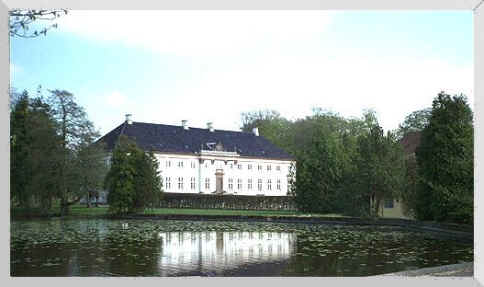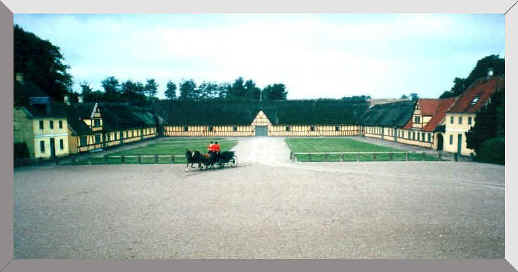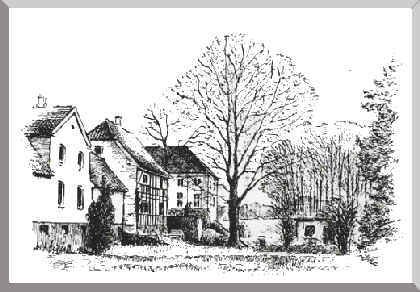

South of Frøbjerg (131 m), the highest point of Funen, is found
Krengerup surrounded by its forests.
The name dates from 1514, when it was called Krenckeroppe. About
1590 Krengerup was established as an estate. At that time it was
owned by the family Knudsen Akeleye.
In 1770 it was bought by Christian Rantzau and in 1772 his son Frederik Sigfred constructed the beautiful manor-house as it can be seen
today.
It became one of the grandest manor-house sites from the
neo-classical period.
The total design is an expression of the feeling of the noblemen
to be far above the rest of the population. This is underlined by
the distance between the manor-house and the farming houses, and
it is also underlined through the style, the choice of materials
and colours, the thatching, and not least in the difference of
the heights of the buildings.
~~~~~~~~
The Manor-house.
The
architect of the manor-house was Hans Næss. But without a strong
influence from his master N. H. Jardin, the French royal
constructor, the manor-house would not have been the
architectonic unity established with a firm hand as was the case.
The manor-house is constructed in firm neoclassical style with
the symmetric principle underlined by the white colour with dark
sandstone fillets and columns.
The high basement with kitchen facilities and administration
rooms provides a solid foundation. Above the basement is placed
the lofty main floor to which the main stairs lead. All the
representative rooms are found here and a hall going all the way
through the house. Among other things it is used for the summer
concerts of Vestfyns musiske Selskab. A double staircase
leads to the upper storey, which contains bedrooms and guestrooms
and is only half as lofty as the main floor.
The interior of the manor-house and most
of the furniture is from the period 1770-1780 and has been in the
house since it was first inhabited.
Krengerup estate is still owned by
the Rantzau family.
~~~~~~~~
The
farm houses.

The beautiful farm buildings at the end of the
long courtyard to the west were constructed at the same time as
the manor-house, also by Frederik Sigfred Rantzau. A beam in the
barn carries the inscription 1773. The buildings are made in
heavy half-timber with thatched roofs on the axis going through
the entire design. Two tile roofed pavilions nearest to the
manor-house were constructed in the mid 1800s.
One pavilion was provided with a water wheel in
the mill channel under the courtyard and provided power for the
grinding mill in the barn. This arrangement supplanted actually
the horses in the horse treadmill which can still be seen as an
addition on the west side of the barn.
The other pavilion was arranged as a dairy. New
farm buildings were made late in the 1800s immediately north of
the old farm buildings.

The entity forms a rare beautiful harmony.
~~~~~~~~